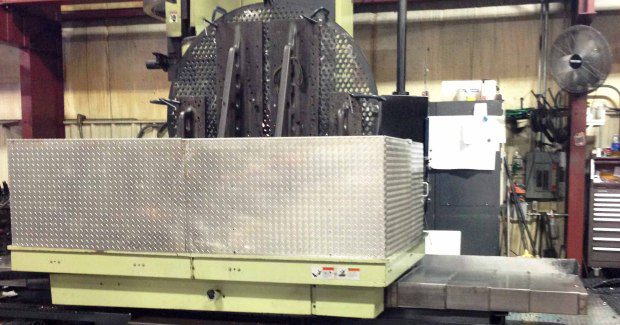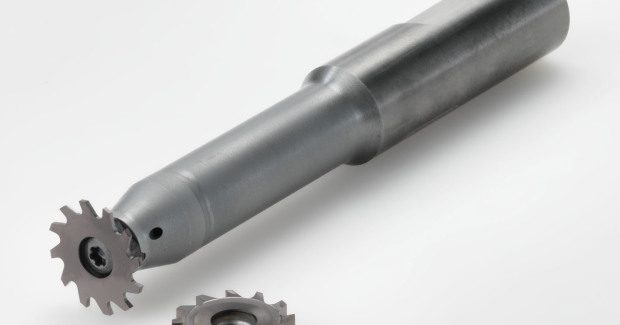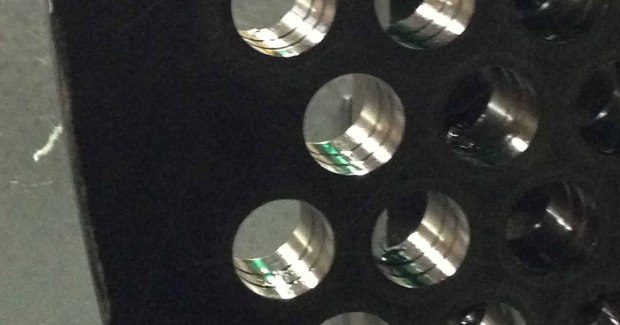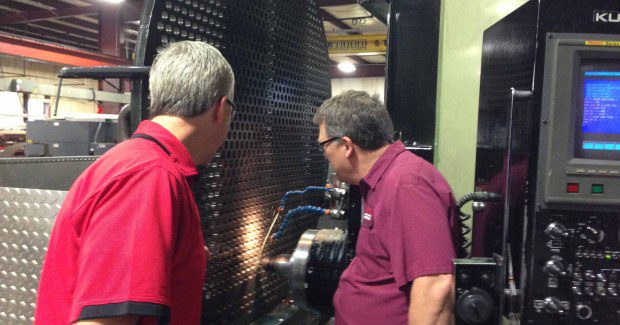Game Changer
A twelve-tooth groove milling tool bites 19 hours off the 80-hour cycle time on a tough-to-machine part and keeps potentially outsourced work in-house – with greater profit.
Posted: November 6, 2014
You know you have a problem workpiece on your hands when your outsourcing vendors turn down the work. Hard-to-process parts can do that. As a result, an already full backlog at Cambron Engineering (Bay City, MI) now overflowed, creating strong company interest in cycle time reduction for a particularly vexing feature on the parts. A chance encounter with application engineer Brett Kischnick of Horn USA Inc. (Franklin, TN) satisfied that interest with a new tooling approach that cut cycle time from 59 seconds down to ten seconds for the feature, taking 19 hours out of the part’s 80 hours total machining time.
The two parts are Inconel 600 (nickel, chromium, iron) plate, about eight ft diameter and 1.875 in thick, to be used as tube sheets in a shell-and-tube heat exchanger, an ideal application for this strong, heat/corrosion resistant material. Each disc must be drilled through with 1,400 1.5 in diameter holes, each with two 0.126 in (wide) x 0.015 in (deep) grooves milled into the circumference of each bore.
This is a touchy and tough piece of work, with the material alone worth about $60,000, according to Cambron tool engineer Bryon Christilaw. But it’s well within the capability of this go-to supplier for nine GM plants, which has a climate-controlled 33,000 sq ft shop and 47-person staff capable of design and manufacture of gages, dies, tooling, fixtures, and special machinery, as well as CNC machining of large fabrications.
“These parts come through several times a year and, on one occasion, with our backlog already high, we needed to outsource the work,” said Christilaw. “The material and features proved a major problem, however, and no one wanted to touch it.”
Cambron machines these parts on a 25 hp Kuraki boring mill, and the interpolated grooving cuts were particularly difficult. “We were using a 3-flute, 0.125 in wide groove milling insert that was 0.697 in diameter,” explained Christilaw. Running at 750 rpm and a 9 ipm feedrate with 0.004 in per tooth engagement, each groove took about 30 seconds – consuming 19 hours of the part’s 80-hour machining time. “This didn’t include the operator’s time for in-process measurements, cutter compensation and insert changes,” he added.
A part this size and configuration naturally attracts attention when fixtured up, so Kischnick, who was already visiting the shop to handle questions about lathe grooving, asked the operator about it and learned about the tool life and cycle time issues. He later proposed a solution with a Horn 713 12-flute groove milling insert, 0.854 in diameter and 0.118 in wide. The small differences prove what a game-of-inches machining can be, because the new insert reduced cycle time for each groove from 30 seconds to five seconds.
Here’s how. The larger tool diameter – just 0.157 in larger – reduces the length per cut from 1.830 in to 1.337 in, or about 27 percent. Increasing the number of cutter teeth from 3 to 12 allows a 400 percent increase in federate, from 9 ipm to 36 ipm, while maintaining the same 0.004 in per tooth engagement.
In addition, the smaller width of the 12-tooth tool (0.118 in vs. 0.125 in) leaves 0.008 in material for the second pass on each groove. This produces a larger chip to minimize heat buildup in the tool, which is amplified when trying to ‘rub off’ 0.001 in. “It is important to have enough stock to produce a good chip to carry the heat away,” explained Kischnick. “Otherwise, the tool will absorb more cutting heat. The cooler the tool, the longer it stays sharp.”
In fact, the 12-tooth tool lasts nearly three times as long as the 3-tooth tool: 45 minutes vs. 18 minutes. The 713 12-tooth milling cutters produce a very smooth cut. They are designed for grooves up to 0.185 in deep and 0.039 in to 0.118 in wide in holes as small as 0.886 in diameter. They are screwed to the front face of a standard carbide shank, and utilize straight or staggered cutting edges, depending on the width. “These tiny grooves had always taken a big chunk of the total cycle time, but this new tool cuts that down to a proportion that’s more in line with their size,” added Christilaw. “Anytime you can cut 25 percent off the cycle time for a part by simply going to a different style tool, it’s a real game changer.”
Horn USA, Inc., 320 Premier Court, Suite 205, Franklin, TN 37067, 888-818-4676, technicalsales@hornusa.com, www.hornusa.com.














